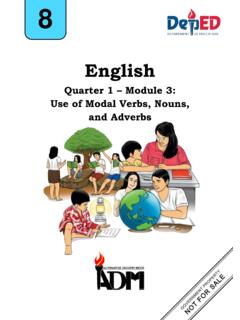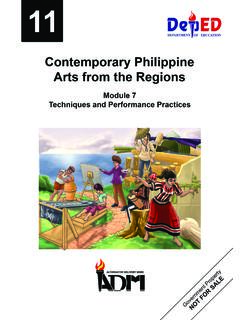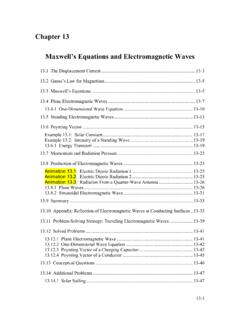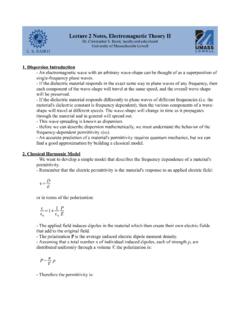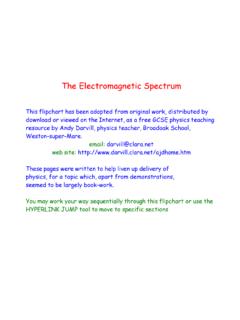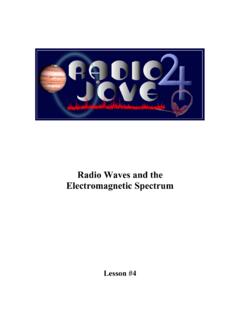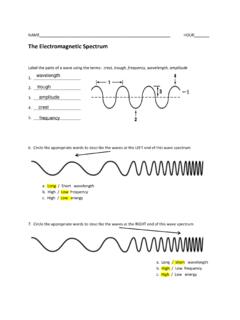Transcription of Quarter 2 Module 1 ELECTROMAGNETIC WAVES
1 Republic of the Philippines Department of Education Regional Office IX, Zamboanga Peninsula Zest for Progress Zeal of Partnership 10 SCIENCE Grade10 Quarter 2 Module 1 ELECTROMAGNETIC WAVES Name of Learner: _____ Grade & Section: _____ Name of School: _____ 2 What I Need to Know When you were in Grade 7, you were able to demonstrate understanding of the characteristics of light by explaining color and intensity of light in terms of its wave characteristics. In Grade 8, you grasped the knowledge about some of properties and characteristics of light by explaining the hierarchy of colors in relation to the energy of visible light. This time, it will be all about comparing the relative wavelengths of different forms of ELECTROMAGNETIC WAVES . Have you ever tried sending messages, cooking in a microwave, listening radio or watching TV today?
2 Have you ever tried to ask yourself What makes this possible? . As you go along this Module , you will able to answer that BIG question. Content Standard The different regions of ELECTROMAGNETIC Spectrum Most Essential Learning Competency (MELC) Compare the relative wavelengths of different forms of ELECTROMAGNETIC wave (S10FE 11a-b-470) Specific Objectives: a. Trace the development of the ELECTROMAGNETIC wave theory b. Describe how ELECTROMAGNETIC wave is produced and propagated. Module 1 ELECTROMAGNETIC WAVES 3 What s In Let us recall the dispersion of light that you learned in Grade 8. This is when white light splits into many colors as it passes through a prism, thus creating a rainbow. Trivia: A rainbow is caused by sunlight and atmospheric conditions. Light enters a water droplet, slowing down and bending as it goes from air to denser water.
3 The light reflects off the inside of the droplet, separating into its component wavelengths--or colors. When light exits the droplet, it makes a rainbow. (Source: #:~:text=A%20rainbow%20is%20caused%20by, droplet%2C%20it%20makes%20a%20rainbow.) ACTIVITY 1: SHINE LIKE RAINBOW! Directions: In the left box below, write the 7 colors of the rainbow arranged from top to bottom in the space provided ( point each). In the right box below, write T if the statement about energy, frequency and wavelength is true and F if the statement is false (1 point each). 1. RED 2. _____ 3. YELLOW 4. _____ 5. _____ 6. INDIGO 7. _____ ___1. Red light has the highest frequency. ___2. Violet has the highest energy. ___3. Violet has the longest wavelength. ___4. The higher the frequency of light, the greater the energy. ___5. The longer the wavelength, the lesser the frequency of light.
4 ___6. Wavelength is directly proportional to frequency. ___7. Frequency is inversely proportional to energy. ___8. Wavelength is inversely proportional to energy. Score: ____ 12 4 What s New ACTIVITY 2A: MATCH ME! Directions: Match the scientists given below with their contributions. Write the letter of the correct answer in the space provided before each number. Scientists Contributions a. Contributed in developing equations that showed the relationship of electricity and magnetism _____2. Faraday b. Showed experimental evidence of ELECTROMAGNETIC WAVES and their link to light _____3. Hertz c. Demonstrated the magnetic effect based on the direction of current _____4.
5 Maxwell d. Formulated the principle behind ELECTROMAGNETIC induction _____5. Oersted e. Showed how a current-carrying wire behaves like a magnet ACTIVITY 2B. LET S TALK ABOUT EM! Directions: Write T if the statement is True, F if the statement is false. (1 point each) _____1. ELECTROMAGNETIC WAVES transfer energy through vacuum. _____ 2. A wave is a disturbance that transfers energy _____ 3. Most EM WAVES are invisible and undetectable. _____ 4. The electric field and the magnetic field oscillate parallel to each other _____ 5. As wavelength increases, the frequency of wave also increases. Score: ____ 5 Score: ____ 5 5 What Is It In the previous activity, you matched the scientists with their contributions on the discoveries of electricity and magnetism and the development of ELECTROMAGNETIC wave theory.
6 Hoping that you got them right. Take a look at this.. James Clerk Maxwell 1831-1879 Andre-Marie Ampere 1775-1836 Hans Christian Oersted 1777--1851 Showed how a current carrying wire behaves like a magnet. Formulated the principle behind ELECTROMAGNETIC induction. Contributed in developing equations that showed the relationship of electricity and magnetism. Showed experimental evidence of ELECTROMAGNETIC WAVES and their link to light. Demonstrated the magnetic effect based on the direction of current. Michael Faraday 1791-1867 Heinrich Hertz 1857--1894 Source: Source: maxwell-inventor1991689 6 ELECTROMAGNETIC WAVES Accelerating electrons produce ELECTROMAGNETIC (EM) WAVES . These WAVES are a combination of electric and magnetic fields. A changing magnetic field produces an electric field and a changing electric field produces a magnetic field.
7 As accelerated electrons produce an electric field of a wave, the varying electric field produces the wave s magnetic field. Both the electric field and the magnetic field oscillate perpendicular to each other and to the direction of the propagating wave. Therefore, ELECTROMAGNETIC WAVES are transverse WAVES , as shown in Figure 1. Figure 1. ELECTROMAGNETIC Wave Propagation Among the examples of EM WAVES are radiowaves, microwaves, infrared, visible light, ultraviolet, x-rays and gamma rays. All EM WAVES travel at a speed of 3 X 108 m/s in a vacuum and denoted as c, the speed of light. Since all the ELECTROMAGNETIC WAVES have the same speed, as wavelength decreases, the frequency of the wave increases as expressed in the equation v= f where: v is the wave speed, or c (speed of light) expressed in meter per second, f is the frequency expressed in Hertz is the wavelength expressed in meters Speed All ELECTROMAGNETIC WAVES travel at a speed of 300,000 km/s (3 x 108m/s) in a vacuum of space.
8 However, when ELECTROMAGNETIC WAVES travel through matter, they slow down. The speed of the wave depends upon the material they travel through. 7 ELECTROMAGNETIC WAVES usually travel the slowest in solids and the fastest in gases, as shown in Table 1 below. Material Speed (Km/s) Vacuum 300,000 Air Slightly less than 300,000 Water 226,000 Glass 200,000 Diamond 124,000 Table 1. Speed of Visible Light Frequency The frequency, represented by the Greek letter nu ( ), is the number of WAVES that pass a certain point in a specified amount of time. Typically, frequency is measured in units of cycles per second or WAVES per second. One wave per second is also called a Hertz (Hz) and in SI units is a reciprocal second (s 1). Example Problem 1: (Assume that the WAVES propagate in a vacuum.) 1. What is the frequency of radio WAVES with wavelength of 20 m?
9 Given: v= c = 3 X 108 m/s = 20 m f= ? Equation: v=c= f Solution: f=c/ = 3 X108 m/s 20 m = X 107 Hz Wavelength Wavelength is defined as the distance measured from one crest of a wave to the next crest or from one through to the second through. A wave cycle consists of one complete wave starting at the zero point, going up to a wave crest, going back down to a wave trough, and back to the zero point again. The wavelength of a wave is the Figure 2. The wavelength 8 distance between any two corresponding points on adjacent WAVES . It is easiest to visualize the wavelength of a wave as the distance from one wave crest to the next.
10 In an equation, wavelength is represented by the Greek letter lambda ( ). Depending on the type of wave, wavelength can be measured in meters, centimeters, or nanometers (1 m = 109 nm). To find wavelength ( ), use this equation v= f Example Problem 2: 1. What is the wavelength of an ELECTROMAGNETIC wave that has a frequency of 1014 Hz? Given : f = x 1014 Hz v= c= x 108 m/s =? Equation: v= f What s More ACTIVITY 3: SOLVE ME! Directions: Solve the problem. Write all your solutions and answers on the space provided after the question. 1. Calculate the wavelength of a photon that has a frequency of x 1012Hz. (5 points) . 2. What is the frequency of an ELECTROMAGNETIC wave having a wavelength of 300,000 km?




